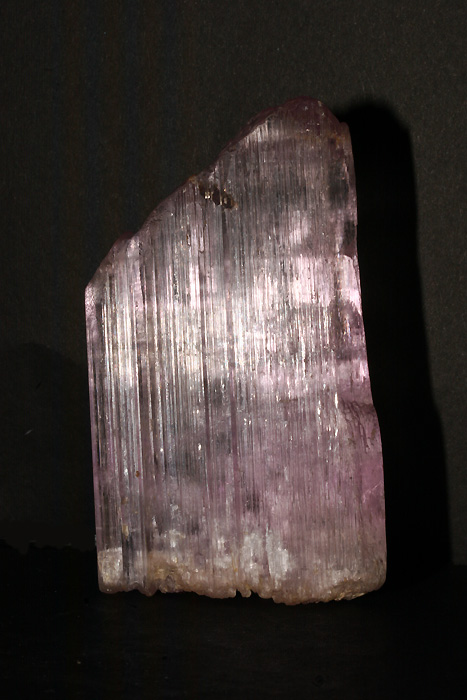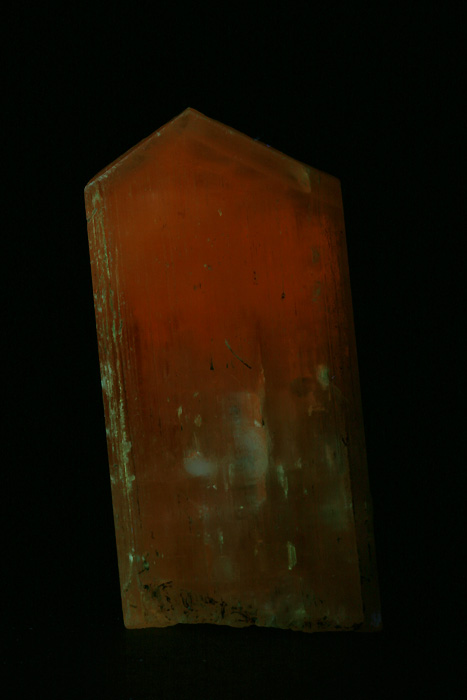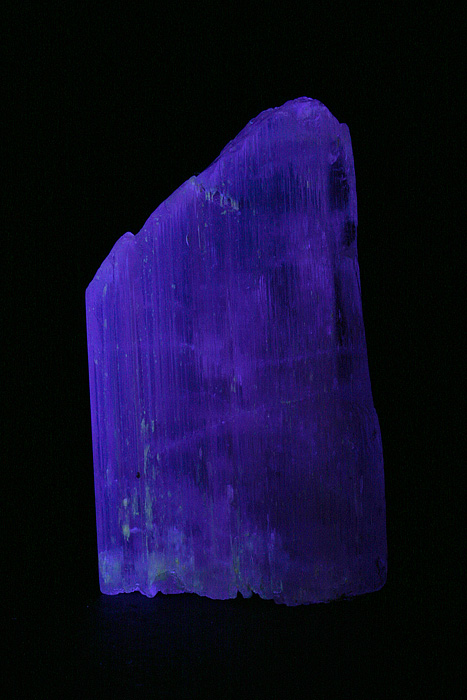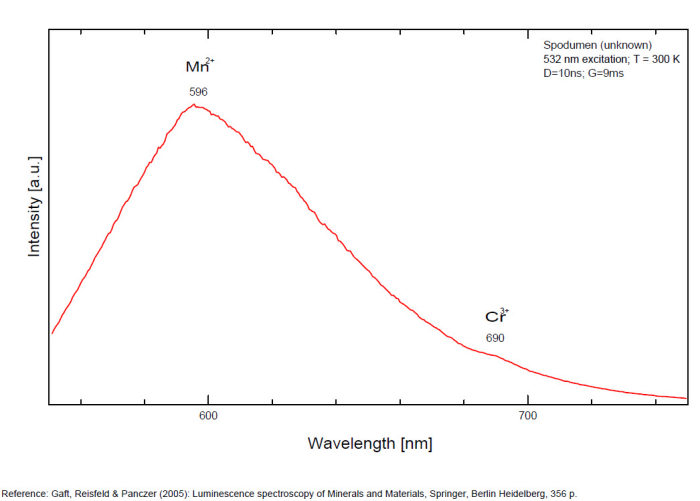Database of luminescent minerals
SPODUMENE
Chemical formula: LiAlSi2O6
Family: Silicates
Status: IMA-A
Crystal system : Monoclinic
Display mineral: OUI
Associated names (luminescent varieties, discredited names, synonyms, etc.): hiddenite, kunzite,
Luminescence:
Longwave UV (365nm) colors: |
Orange Red , Orange , Tawn , Orange Red , Violet Pink , Salmon pink , | ||
Shortwave UV (254nm) colors: |
Orange , Blue , | ||
Longwave (365nm) picture

OL (365 nm). Col. G. Barmarin; Photo: G. Barmarin
Pictures Galery:



 ...
...Do you have a photo of this mineral you would like to see in the gallery? Contact us!
Phosphorescence (in the common sense of the term) observable with the naked eye:
Type d'UV |
Couleur |
Intensité |
Fréquence d'observation |
|---|---|---|---|
UV longs (365nm): | Orange | UV moyens (320 nm): | Orange | UV courts (254 nm): | Orange |
Tenebrescence: OUI

Thermoluminescence: OUI
Comments:
Variety triphane (colorless), Kunzite (pink) and Hiddenite (green).
Activator(s) and spectrum:
Activator(s): Mn2+ , Cr3+, Fe3+,
Peaks in the spectrum (nm):
Mn2+ substituting for Li : broad band around 595 - 615nm (10ms) Cr3+ : 676, 690nm (peak) Fe3+ : 685nm (5 ms)

Spectrum: Michael Gaft, Petah Tikva, Israel. Plot: Institute of Mineralogy, University of Vienna, Austria, with permission of the authors.
Comments on spectrum and activators:
Mn2+ is shown to be mainly in Li-sites rather than Al-sites and gives rise to a broad emission centered at 600 nm. In Cr-rich crystals only one R1 line is observed and Cr3+ emission is evident at room temperature. In green hiddenite crystals, Cr3+ emission is dominant at room temperature where the R-lines are superimposed on a broad-band emission. (Source: Luminescence spectroscopy of Cr3+ and Mn2+ in spodumene (LiAlSi2O6), WALKER G. see below). Spodumen is a monoclinic pyroxene with two not equivalent metal cation sites M1 and M2. The aluminum occupies the smaller M1 site, which is approximately octahedral (actual symmetry C2) with an average metal-oxygen distance of 1.92 A. The M2 site, occupied by Li, is also six-fold coordinated with an average metal-oxygen distance of 2.23 Å. Both Al and Li sites may be substitutionally replaced by ions of the transitional metals in various proportions. Both Mn2+ and Cr3+ centers have been identified in luminescence spectra by steadystate spectroscopy (Tarashchan 1978; Walker et al. 1997). Besides, long lived deep red luminescence was found supposedly generated by Fe3+ especially in the specimen fluorescing a bright lilac color under SW, light peach LW and having a violet (not pink) color in daylight. At room and lower temperatures only one emission band of Mn2+ occurs. It is very probable that Mn2+ ions in the spodumen matrix is present only in one site and that Mn2+ is mainly in Li-sites rather than Al-sites. (Gaft)
Best localities for fluorescence (*):
- Hunza Mine, Gilgit Region, Pakistan;
- Kolum District, Nuristan Region, Afghanistan;
- Kunar Province, Afghanistan;
- Laghman Province, Afghanistan;
- Dara-i-Pech pegmatite field, Chapa Dara District, Konar Province, Afghanistan (orange LW,lilac SW+phosphp);
- Minas Gerais, Brazil;
- Pala Chief Mine, Chief Mountain, Pala, Pala District, San Diego Co., California, USA (dull luminescence);
- Strickland Quarry, Strickland pegmatite, Collins Hill, Portland, Middlesex Co., Connecticut, USA (pink LW, Blue SW);
- Stony Point, Alexander Co., North Carolina, USA (strong LW, dull SW);
- Oceanview Mine, Elizabeth R. Mine, Chief Mountain, Pala, Pala District, San Diego Co., California, USA ( intense UV fluorescence as well as phosphorescence);
(*)The data are not exhaustive and are limited to a few remarkable localities for fluorescence
Bibliographic reference for luminescence:
- The Henkel Glossary of Fluorescent Minerals, Dr. Gerhard Henkel, Published by the FMS, 1989 ,
- Fluorescence: Gems and Minerals Under Ultraviolet Light, Manuel Robbins, 1994, Geoscience Press, ISBN 0-945005-13-X ,
- The World of Fluorescent Minerals, Stuart Schneider, Schiffer Publishing, 2006, ISBN 0-7643-2544-2 ,
- Luminescence Spectroscopy of Minerals and Materials, M. Gaft, R. Reisfeld, G. Panczer, Springer Editor, ISBN: 10 3-540-21918-8 ,
Reference for luminescence on the Internet:
- Composition, tenebrescence and luminescence of spodumene minerals, Esther W. Claffy, American Mineralogist vol38
- Luminescence spectroscopy of Cr3+ and Mn2+ in spodumene (LiAlSi2O6), Walker G., El Jaer A., Sherlock R., Glynn T. J., Czaja M., Mazurak Z., Journal of luminescence, 1997, vol. 72-74, pp. 278-280
Images:
- Minas Gerais, Brazil: http://www.mindat.org/photo-87001.html
- Strickland Quarry LW, USA: http://www.mindat.org/photo-337838.html
- Strickland Quarry SW, USA: http://www.mindat.org/photo-337839.html
- Laghman Province, Afghanistan: http://www.mindat.org/photo-613704.html
- Laghman Province, Afghanistan : https://www.mindat.org/photo-525454.html
- Dara-i-Pech pegmatite field, Afghanistan: http://www.mindat.org/photo-665586.html
- Kunar, Afghanistan (including phosphorescence): https://www.mindat.org/photo-754998.html
Mineralogical reference on the Internet:
 http://www.mindat.org/show.php?name=Spodumene
http://www.mindat.org/show.php?name=Spodumene
 http://webmineral.com/data/Spodumene.shtml
http://webmineral.com/data/Spodumene.shtml
Internet Search:
 Image search on 'Google Images'
Image search on 'Google Images'
 Search for documents in all languages on Google
Search for documents in all languages on Google
A request providing no result means only that no such reference exists in the database, but it does not mean that what you are looking for does not exist, just not to our knowledge. If you think you have found an error or omission, please let us know via the contact page being sure to cite the source of information.

